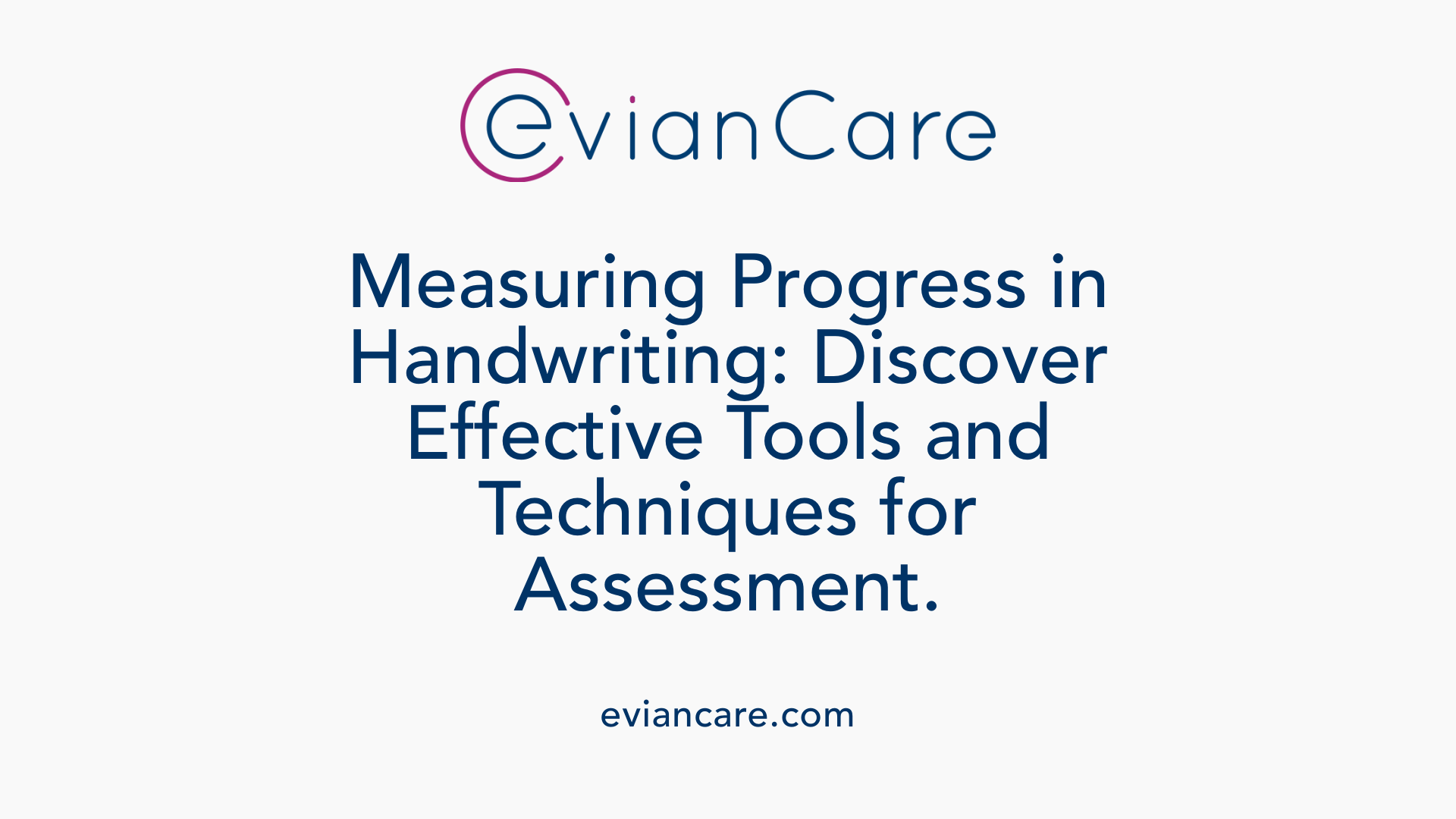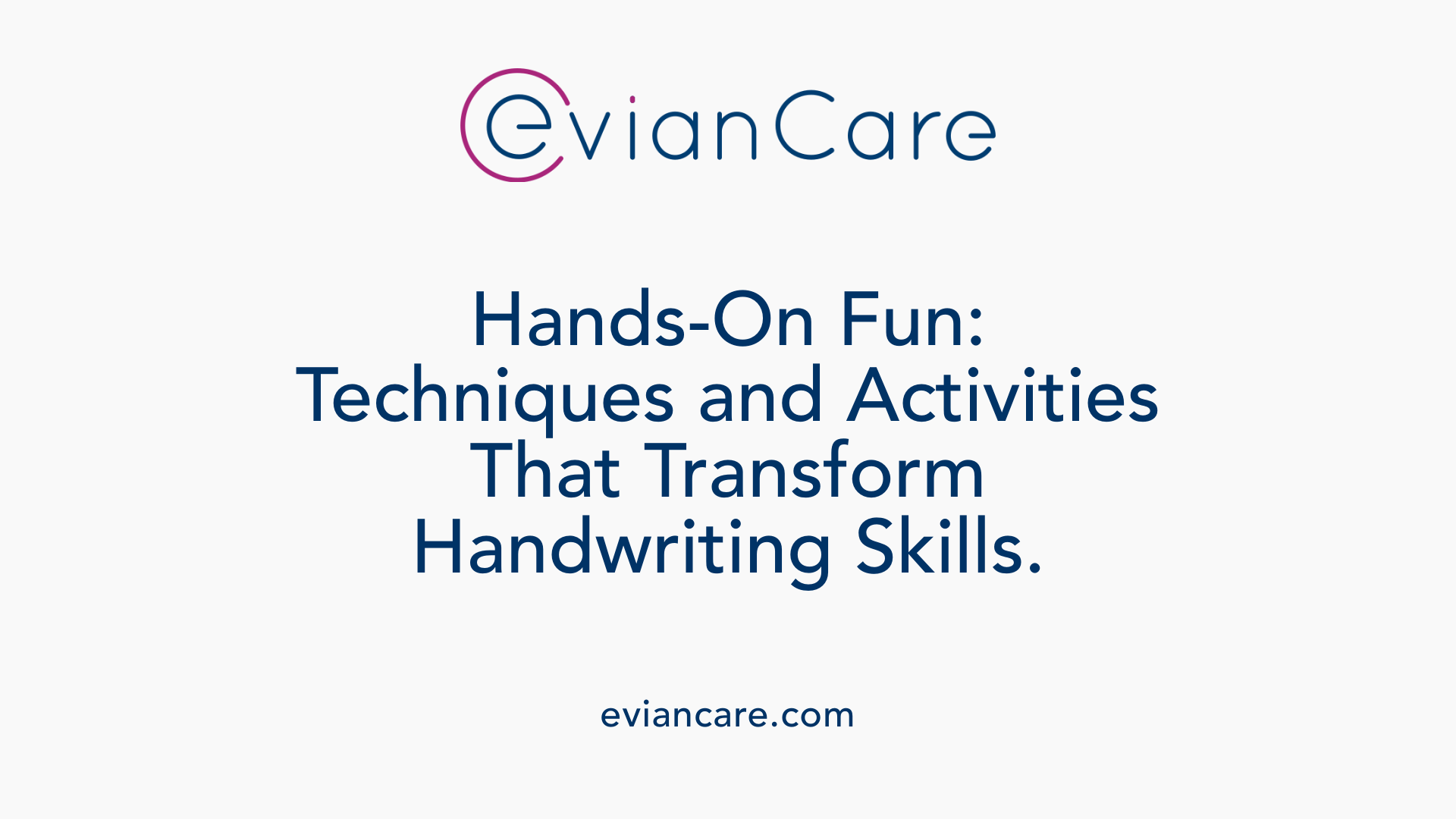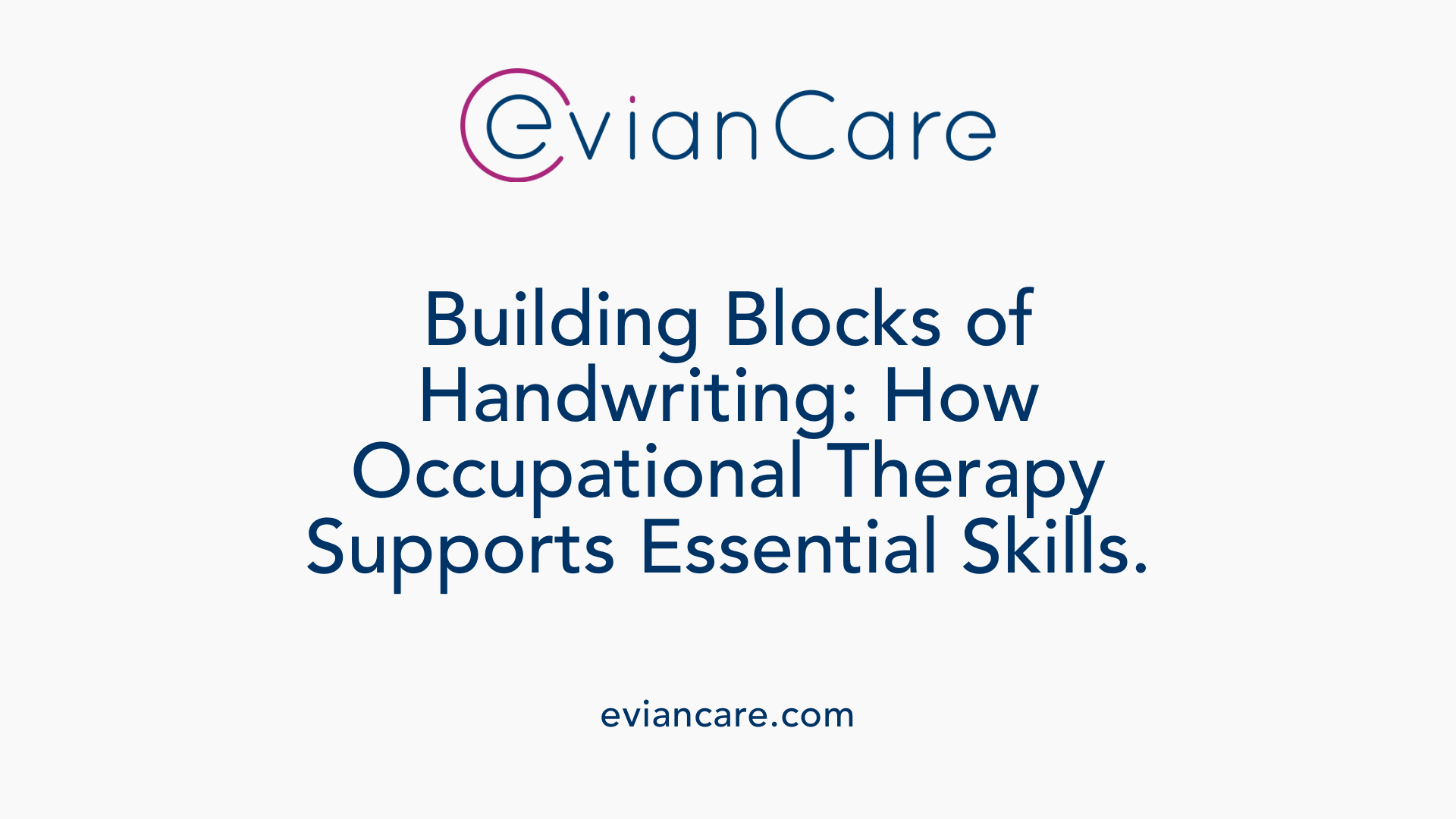
Understanding the Role of Occupational Therapy in Handwriting Development
Handwriting is a multifaceted skill that involves motor coordination, sensory processing, and executive functioning. For children facing challenges in producing legible handwriting, occupational therapy offers targeted strategies and interventions to enhance these foundational skills, promoting academic success and self-confidence.
The Goals and Benefits of Occupational Therapy in Handwriting Improvement

What are the goals and benefits of occupational therapy in improving handwriting?
Occupational therapy aims to enhance children's handwriting by targeting a variety of underlying skills necessary for clear and efficient writing. One primary focus is on developing fine motor skills such as strengthening the pincer grip, improving finger dexterity, and increasing hand muscle strength through activities like playing with clay, threading beads, or using tongs. These foundational skills support better control of writing tools and movements.
In addition, therapy addresses visual-perceptual and cognitive skills critical for legible handwriting. Skills such as visual-spatial awareness, planning, and organization influence letter formation, spacing, and alignment. Improving these areas helps children produce writing that’s more readable and consistent.
Postural control and hand-eye coordination are also emphasized, as good posture ensures stability, and coordinated eye movements aid in smooth, controlled writing. Occupational therapists work on these aspects by teaching proper sitting posture, providing ergonomic adjustments, and integrating activities that improve coordination.
To facilitate skill acquisition, therapists often use multi-sensory techniques like tracing letters in sand, shaving cream, or salt to promote proper letter formation in a fun, engaging way. These approaches help children develop automaticity in writing and reduce frustration.
The benefits of occupational therapy extend beyond improved legibility. Children often experience increased confidence and comfort while writing, which can positively influence their participation in classroom activities. Improved handwriting can lead to greater academic success and enhanced self-esteem, empowering children to express themselves more effectively.
Overall, occupational therapy supports holistic development—covering physical, cognitive, and emotional domains—to help children achieve functional, automatic handwriting and participate fully in educational and everyday activities.
Assessing Handwriting Legibility: Tools and Techniques

Are there measurable ways to assess handwriting legibility?
Yes, there are established methods for evaluating handwriting legibility, making it possible to quantify and track progress precisely. A prominent tool used in both research and practice is the Handwriting Legibility Scale (HLS). This scale assesses five core components: overall legibility, effort required, layout, letter formation, and any visible alterations.
The HLS rates each aspect on a 5-point scale, from poor to excellent, providing a comprehensive picture of handwriting quality. It is designed to be quick and straightforward, suitable for use by teachers, therapists, or clinicians with minimal training.
This scale has been validated across various populations and scripts, ensuring its broad applicability. Studies in the UK and Italy confirm its reliability and validity, demonstrating that it can distinguish effectively between good and poor handwriting.
In classroom and clinical settings, the HLS allows for consistent monitoring of handwriting development, identification of specific areas needing intervention, and evaluation of intervention outcomes. Its standardized approach enhances objectivity, ensuring that assessments are systematic and data-driven.
Supporting Parents and Teachers in Handwriting Development

How can parents or teachers assist in improving handwriting?
Supporting children in developing clear and automatic handwriting involves multiple approaches. Engaging children in sensory and play-based activities can significantly boost their fine motor skills and hand strength, which are crucial for legible writing. Activities such as drawing, coloring, or manipulating textured materials like Play-Doh and sand help children develop the necessary muscle control and coordination.
Explicit instruction plays a vital role. Teachers and parents should focus on teaching proper letter formation and spacing from an early age. Using visual cues, models, and consistent practice helps children understand the correct size and placement of letters. For older children, tools like pencil grips or adaptive paper can make writing easier and more comfortable.
Multisensory approaches are especially effective. Techniques such as tracing letters in sand, clay, or shaving cream provide tactile feedback, reinforcing letter shapes and improving muscle memory. Incorporating movement (like hand rotations or jumping activities) while practicing writing can make learning more dynamic and engaging.
Adjusting the writing environment is also important. Ensuring that the workspace has a suitable desk and chair fit, along with appropriate paper size and lined paper, helps children maintain proper posture and alignment. These modifications can reduce frustration and improve overall handwriting quality.
Consistency is essential. Daily practice with structured activities, combined with positive reinforcement, helps establish good habits. Collaborating with occupational therapists for tailored strategies ensures that specific challenges like visual-motor integration or sensory processing difficulties are addressed. Overall, a supportive, playful, and systematic approach helps children develop confidence and proficiency in handwriting.
Techniques and Activities Employed in Occupational Therapy

What techniques or activities can be used in occupational therapy to enhance handwriting skills?
Occupational therapists employ a variety of engaging activities to improve children's handwriting abilities. Sensory-rich activities play a crucial role; for example, children practice letter formation using textured materials like sandpaper, Play-Doh, or salt to enhance tactile feedback and sensory integration.
Fine motor exercises are also fundamental. These include activities such as grasping patterned objects, threading beads or laces, and practicing cutting with scissors. Such exercises strengthen hand and finger muscles and improve control, which are essential for legible handwriting.
Merely focusing on motor skills isn't enough. Adaptive tools like pencil grips, slant boards, and visual positioning aids can assist children in maintaining proper posture and grip. These tools promote better control and reduce fatigue during writing tasks.
Movement-based activities support coordination and sensory processing, vital for handwriting. Games like Simon Says, obstacle courses, or targeted gross motor tasks help develop the coordination needed for efficient writing.
Motor planning and line awareness exercises are incorporated to teach children how to organize writing strokes and understand spatial relationships. For instance, they might trace lines, shapes, and patterns that improve their awareness of spacing, size, and letter formation.
Overall, individualized occupational therapy programs combine these techniques to address specific challenges in fine motor control, visual-perceptual skills, and sensory integration. Through consistent practice and tailored activities, children can achieve greater confidence, legibility, and ease in their handwriting, setting a foundation for academic success and improved self-esteem.
Core Components of Handwriting Development Addressed by Occupational Therapy

What are the components of handwriting that occupational therapy can help develop?
Occupational therapy plays a vital role in enhancing various elements essential for effective handwriting. These include fine motor skills such as grasp, strength, and coordination, which are fundamental for controlling a pencil or pen. OT also focuses on visual-motor integration and perceptual skills—knowing how to coordinate visual input with motor output—and sensory processing, which helps children manage sensory inputs that might interfere with their writing ability.
Postural control and body awareness are crucial for maintaining proper seating and positioning, providing a stable foundation for writing tasks. Good posture supports arm movement and reduces fatigue, allowing for better control over handwriting movements.
Furthermore, OT addresses executive functioning skills—such as planning, organization, attention, and motor planning (praxis). These cognitive abilities are necessary for sequencing letters, maintaining spacing, and overall task management.
Interventions often incorporate multi-sensory activities like tracing in sand or shaving cream to reinforce letter formation and motor patterns. Adaptive strategies and environmental modifications, such as ergonomic desks, specialized tools, or visual cues, help create a conducive learning environment.
By targeting these areas collectively, occupational therapy fosters improvements in handwriting clarity, speed, and overall confidence, ultimately supporting academic achievement and daily independence.
Supporting Continuous Improvement and Lifespan Benefits of Handwriting Therapy
How does handwriting therapy benefit individuals beyond childhood?
Handwriting therapy is not just beneficial for young children learning to write. It offers lifelong advantages that support cognitive, emotional, and physical well-being. For adults, especially those with neurological or motor impairments, therapy can improve handwriting speed, clarity, and comfort, making everyday writing tasks more manageable.
These interventions also strengthen connections within the brain, promoting better neural pathways and cognitive reserves. Such enhancements can help slow age-related cognitive decline and support mental sharpness.
Practicing handwriting helps develop fine motor skills, visual-motor integration, and sensory processing—foundations for memory, language complexity, and attention to detail. Beyond functional benefits, handwriting serves as a powerful tool for organizing thoughts, managing stress, and facilitating emotional expression.
In recent years, advancements in digital technology and artificial intelligence have led to more personalized and accessible handwriting programs. These tools adapt to individual needs, providing ongoing support for maintaining and improving handwriting skills across all ages. Ultimately, handwriting therapy extends its positive influence from childhood into adulthood and old age, fostering lifelong cognitive and emotional resilience.
The Critical Role of Executive and Cognitive Skills in Handwriting Development and the Support Provided by Therapy
What role do executive and cognitive skills play in developing legible handwriting, and how can therapy support these areas?
Handwriting is not just about forming letters; it involves complex mental processes known as executive functions. These include planning, organization, attention control, working memory, inhibition, and cognitive flexibility. Each of these skills is vital for producing legible, consistent handwriting.
Planning and organization help in structuring the task before writing, such as deciding what to write and how to space letters. Attention control keeps the focus on the task, preventing distractions that could lead to sloppy letter formation or poor spacing.
Working memory allows children to hold instructions, letter shapes, and spelling patterns in mind as they write. Inhibition helps suppress impulsive behaviors, ensuring careful pencil control instead of rushing through. Cognitive flexibility enables children to switch between tasks, such as moving from writing letters to checking for errors.
Research and neuroimaging studies show that handwriting activates multiple areas of the brain, including regions responsible for motor control, visual processing, and memory. These neural pathways are strengthened through consistent practice and targeted therapy.
Occupational therapy plays a crucial role in supporting these skills. It employs strategies like visual cues, graphic organizers, self-assessment, and activities designed to boost executive functioning. For instance, children might use checklists or self-monitoring tools to track their progress during handwriting exercises.
Therapists may also incorporate games or tasks that challenge and develop working memory and cognitive flexibility, such as puzzles or memory matching. Sensory integration and perceptual-motor activities help improve coordination and focus, further supporting handwriting.
By strengthening executive functions, therapy enhances not only the quality of handwriting but also speed and overall confidence in writing tasks. The result is more automatic, efficient, and legible handwriting, which is fundamental to academic success and expressive communication.
Summing Up the Impact of Occupational Interventions on Child Literacy
Occupational therapy provides a comprehensive approach to improving handwriting legibility, addressing motor, sensory, perceptual, and cognitive factors. Through evidence-based strategies, tailored interventions, and ongoing assessments, therapists empower children to develop automatic, fluent, and legible handwriting. This improvement enhances academic performance, fosters confidence, and promotes lifelong skills necessary for effective communication. As research continues to evolve, integrating emerging techniques with core principles ensures that occupational therapy remains a vital resource in supporting children’s literacy development.
References
- Tips for Legible Handwriting - The OT Toolbox
- How Can Occupational Therapy Improve My Child's Handwriting?
- Curriculum-Based Handwriting Programs: A Systematic Review With ...
- Sh! 3 Easy Handwriting Secrets To Help Improve Legible Handwriting
- Top 3 Effective Handwriting Interventions - Apply EBP
- Executive Skills for Handwriting
- Improving Your Child's Handwriting Skills - JCFS Chicago
- 5 OT Tips for Improving Handwriting Legibility - The Autism Helper
- Handwriting Challenges in Children: Solutions From an OT












